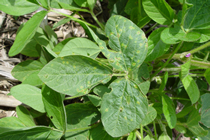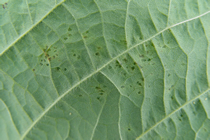By Loren J. Giesler, Former Extension Plant Pathologist
Pathogen
Bacterial blight (Pseudomonas savastanoi) of soybeans is typically an early season disease, which over winters in the field on plant residue. Initial infection of soybeans occurs when wind or splashing water droplets from plant residue on the soil surface to the leaves carry bacterial cells. The bacteria enter the plants through stomata and wounds on leaves. In order for infection to occur, the leaf surface must be wet. Seedlings may be infected through infected seed.
Bacteria that enter the host produce a toxin, which prevents chlorophyll production. Bacteria can also be spread to uninfected leaves when they rub against infected ones during cultivation, rain, and wind.
Video: Bacterial Diseases in Soybean
Disease Symptoms
Brown spots on the margins of the cotyledons characterize plants infected early in the growing season. Young plants may be stunted and if the infection reaches the growing point, they may die. Symptoms in later growth stages include angular lesions, which begin as small yellow to brown spots on the leaves. The centers of the spots will turn a dark reddish-brown and dry out. A yellowish-green "halo" will appear around the edge of water soaked tissue that surrounds the lesions. Eventually the lesions will fall out of the leaf and the foliage will appear ragged. Generally young leaves are most susceptible to blight infection. Lesions can also occur on the pods causing the seeds to become shriveled and discolored. However, seeds usually do not show symptoms.






Favorable Environmental Conditions
Development of bacterial blight is promoted by cool, wet weather (70–80°F). Infection can occur early but is most common at mid season and continues until hot and dry weather limits development. Disease outbreaks often follow windy, rainstorms.
Management
Genetic Resistance
While this disease is not typically yield limiting in Nebraska, producers should consider the following options in problems fields. The best management tool is to prevent disease establishment. Cultivars that are not highly susceptible to the disease should be considered for planting.
Cultural Practices
Crop rotation can be an effective method to avoid inoculum from a previously infected crop. Incorporating crop residue by tillage will reduce the amount of inoculum available in the spring to infect plants but there are moisture and erosion issues to be considered. To prevent the spread of disease, limit cultivation to times when the foliage is dry.
Chemical/Biological Control
Copper fungicides are labeled for control of bacterial blight on soybeans but need to be applied early in the disease cycle to be effective.
Additional Resources
- UNL Extension NebGuide, Bacterial Disease of Soybean (G2058).
- North Central Soybean Research and Information Initiative: Bacterial Blight
